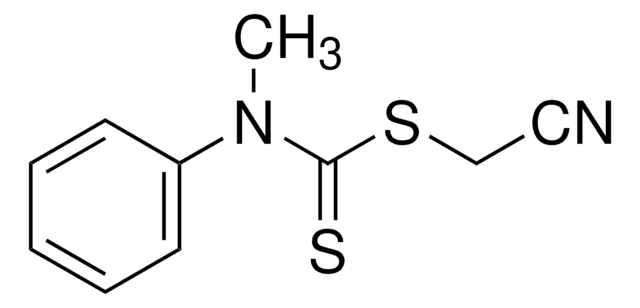731277
2-Cyano-2-propyl 4-cyanobenzodithioate
98% (HPLC)
Sinónimos:
2-Cyanoprop-2-yl 4-cyanodithiobenzoate, 4-Cyanobenzenecarbodithioic acid 1-cyano-1-methylethyl ester
About This Item
Productos recomendados
assay
98% (HPLC)
form
solid
mp
122-127 °C
SMILES string
CC(C)(SC(=S)c1ccc(cc1)C#N)C#N
InChI
1S/C12H10N2S2/c1-12(2,8-14)16-11(15)10-5-3-9(7-13)4-6-10/h3-6H,1-2H3
InChI key
GLQSCQVGVPUIPC-UHFFFAOYSA-N
General description
Application
Legal Information
Certificados de análisis (COA)
Busque Certificados de análisis (COA) introduciendo el número de lote del producto. Los números de lote se encuentran en la etiqueta del producto después de las palabras «Lot» o «Batch»
¿Ya tiene este producto?
Encuentre la documentación para los productos que ha comprado recientemente en la Biblioteca de documentos.
Los clientes también vieron
Artículos
RAFT polymerization uses commercial agents to control polymer properties without cytotoxic heavy metals like ATRP.
RAFT polymerization offers living characteristics to radical polymerization, contributing versatility to reversible deactivation radical polymerization methods.
The modification of biomacromolecules, such as peptides and proteins, through the attachment of synthetic polymers has led to a new family of highly advanced biomaterials with enhanced properties.
Micro review of reversible addition/fragmentation chain transfer (RAFT) polymerization.
Protocolos
RAFT polymerization offers precise control, enabling tailored synthesis of complex polymer structures.
We present an article about RAFT, or Reversible Addition/Fragmentation Chain Transfer, which is a form of living radical polymerization.
We presents an article featuring procedures that describe polymerization of methyl methacrylate and vinyl acetate homopolymers and a block copolymer as performed by researchers at CSIRO.
Polymerization via ATRP procedures demonstrated by Prof. Dave Haddleton's research group at the University of Warwick.
Nuestro equipo de científicos tiene experiencia en todas las áreas de investigación: Ciencias de la vida, Ciencia de los materiales, Síntesis química, Cromatografía, Analítica y muchas otras.
Póngase en contacto con el Servicio técnico

![4-Cyano-4-[(dodecylsulfanylthiocarbonyl)sulfanyl]pentanoic acid 97% (HPLC)](/deepweb/assets/sigmaaldrich/product/structures/204/925/30ae6ca0-5b0b-4963-a061-7e5e3d1a85af/640/30ae6ca0-5b0b-4963-a061-7e5e3d1a85af.png)












